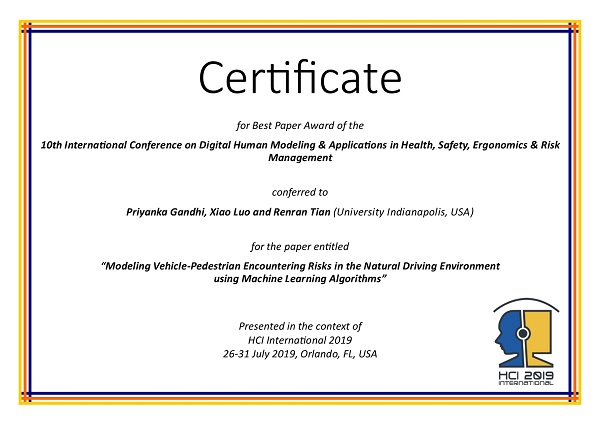
Best Paper Award for the 10th International Conference on Digital Human Modeling & Applications in Health, Safety, Ergonomics & Risk Management, in the context of HCI International 2019, 16-31 July 2019, Orlando, FL, USA

Certificate for Best Paper Award of the 10th International Conference on Digital Human Modeling & Applications in Health, Safety, Ergonomics & Risk Management
conferred to
Priyanka Gandhi, Xiao Luo and Renran Tian
(University Indianapolis, USA)
for the paper entitled
"Modeling Vehicle-Pedestrian Encountering Risks in the Natural Driving Environment using Machine Learning Algorithms"
Presented in the context of
HCI International 2019
16-31 July 2019, Orlando, FL, USA
Paper Abstract
"For modern automated driving systems, interaction with pedestrians in the mixed traffic conditions is one of the most challenging problems. Potential conflict cases have been widely used to study vehicle-pedestrian encountering scenarios in natural road environment. However, these relatively dangerous cases between human drivers and pedestrians are not necessarily the dangerous cases for automated driving systems, especially when trained artificial intelligence systems can predict the potential risks and prepare in advance. In this study, we investigate the performance of machine learning algorithms in detecting potential conflicts between vehicle and pedestrians, as well as prioritizing passing sequences during the conflicts. A total of five commonly-used machine learning algorithms are tested. The results show that Deep Neural Network can predict the potential risk and passing priority very accurately (93% and 96% respectively) solely based on descriptive scenario variables. A set of wrongly classified cases (False Negative) are also collected for further study which represent unpredictable risks for automated driving systems."
The full paper is available through SpringerLink, provided that you have proper access rights.